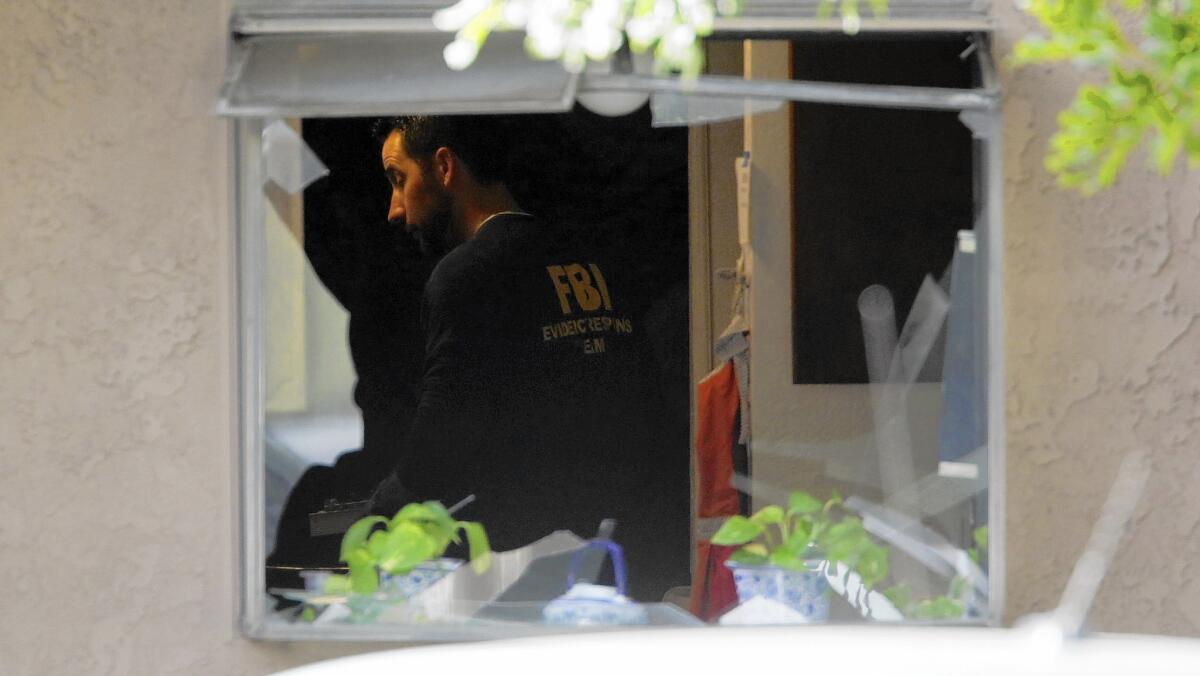Police tactics in San Bernardino rampage win high praise from experts

FBI agents search the Redlands home where the assailants in the San Bernardino mass shooting lived.
- Share via
Lt. Mike Madden was on his way to lunch and happened to be nearby when the first 911 calls came in.
He could tell from the dispatcher’s voice that something out of the ordinary was happening at the center for people with developmental disabilities in San Bernardino.
“We have an active shooter,” Madden reported to the dispatcher, pleading for reinforcements.
A minute later, he entered the building with three other San Bernardino police officers. There, he found 14 people dead and 21 wounded in the nation’s worst mass shooting since the 2012 attack at Sandy Hook Elementary School in Newtown, Conn.
There was a very short response time, they did a follow-up very rapidly and got on top of the suspects. I’m absolutely impressed.
— Scott Reitz, a former Los Angeles Police Department SWAT officer and instructor
“The situation was surreal,” Madden, a 24-year veteran, said Thursday night. “It’s something that we prepare for, and an active shooter, they talk about sensory overload. … It was all of that and more. It was unspeakable the carnage we were seeing.”
Madden’s recollections, along with recordings of Wednesday’s police radio traffic, show how quickly the events unfolded as 300 officers from various agencies sped to the scene, evacuated the victims and tracked down the suspects.
Law enforcement experts on Thursday praised the San Bernardino Police Department, San Bernardino County Sheriff’s Department and others for their handling of the incident.
Follow live coverage of the San Bernardino shooting >>
“There was a very short response time, they did a follow-up very rapidly and got on top of the suspects,” said Scott Reitz, a former Los Angeles Police Department SWAT officer and instructor. “I’m absolutely impressed. That sometimes takes hours or days.”
When Reitz joined the LAPD SWAT team in the 1980s, the biggest threat of mass carnage was from hostage-takers who would demand a ransom or a platform for their views.
Since the Columbine High School shootings in 1999, law enforcement agencies have changed their tactics, rushing into buildings rather than sitting back and waiting.
The San Bernardino officers “did what they were supposed to do: come to the location, get together with a team of three or four or five officers and make entry,” said San Marino Police Chief John Incontro, a former LAPD captain who oversaw the department’s SWAT team. “The goal is to find the suspect and stop the threat.”
As the tragic day wore on and law enforcement officers raced to confront the suspects in their black SUV, images of armored vehicles and officers in tactical gear filled television screens across the country.
The Sheriff’s Department has been one of California’s largest recipients of military-grade equipment under a controversial Pentagon program that transfers surplus weapons and vehicles to local law enforcement.
The program came under fire last year after police in Ferguson, Mo., used armored vehicles and other military equipment to confront demonstrators during protests over the shooting death of a black teenager, Michael Brown, by a white police officer.
Seth Stoughton, a former police officer and a professor at the University of South Carolina School of Law, said use of the equipment should be limited to hostage-takings, active shooters and other violent situations.
“If SWAT and military equipment were restricted to those situations, I don’t think anyone would have a problem with that,” Stoughton said.
Madden said he and his colleagues still believed there were attackers inside the Inland Regional Center. The scene was chaotic, he said, with the air smelling of gunpowder, fire alarms going off, injured people wailing and others with a look of “pure panic” on their faces.
“This was a tragedy I’ve never experienced in my career,” he said. “But we had to deal with it. We had to help bring them to safety.”
[email protected] and [email protected]
Twitter: @cindychangLA and @lacrimes
Times staff writer W.J. Hennigan in Washington contributed to this report.
MORE ON SAN BERNARDINO SHOOTING
Rampage killers led secret life, hiding plans and weapons
Feds probe possible terrorism links in San Bernardino massacre
For victim’s boyfriend, 22 hours of conflicting reports, then heartbreak
More to Read
Sign up for Essential California
The most important California stories and recommendations in your inbox every morning.
You may occasionally receive promotional content from the Los Angeles Times.












